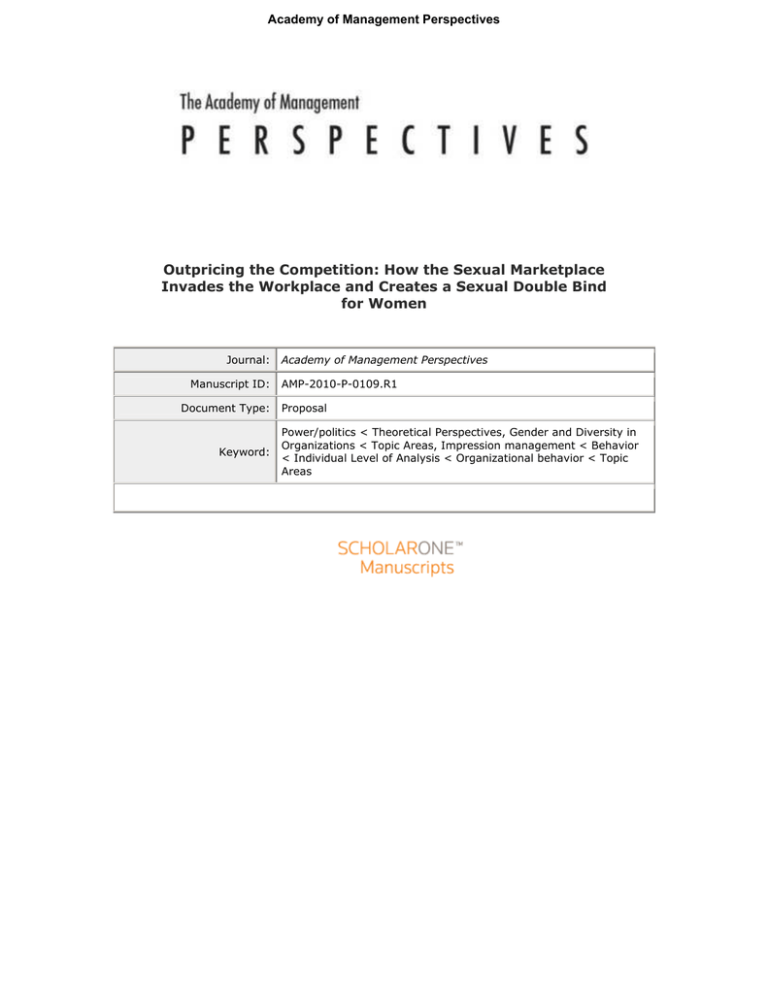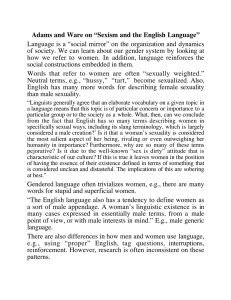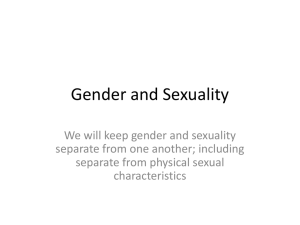
Academy of Management Perspectives
Outpricing the Competition: How the Sexual Marketplace
Invades the Workplace and Creates a Sexual Double Bind
for Women
Journal:
Manuscript ID:
Document Type:
Keyword:
Academy of Management Perspectives
AMP-2010-P-0109.R1
Proposal
Power/politics < Theoretical Perspectives, Gender and Diversity in
Organizations < Topic Areas, Impression management < Behavior
< Individual Level of Analysis < Organizational behavior < Topic
Areas
Page 1 of 4
1
2
3
4
5
6
7
8
9
10
11
12
13
14
15
16
17
18
19
20
21
22
23
24
25
26
27
28
29
30
31
32
33
34
35
36
37
38
39
40
41
42
43
44
45
46
47
48
49
50
51
52
53
54
55
56
57
58
59
60
Academy of Management Perspectives
1
Outpricing the Competition: How the Sexual Marketplace Invades the Workplace and
Creates a Sexual Double Bind for Women
“…one of the greatest tools, or weapons, we have as women is flirting…”
- DiSesa’s (2008, p 105)
Introduction
Controversy seems to surround women who express their sexuality at work. A Harvard
librarian lost a lawsuit in which she claimed she was denied promotions because she was seen as
a ‘sexy girl’ (Associated Press, 2005), a banker was fired because her sexy appearance was
distracting to her male colleagues (Martinez, 2010), and most recently, conversations about a
sports reporter’s negative experience in a male locker room revolved around her sexy attire
(Sheridan & Hartenstein, 2010). Women’s engagement in sexualized expressions is prevalent,
complex, and may be both beneficial and detrimental to them. Indeed, expressions of sexuality
can damage or enhance their work relationships with their colleagues (e.g., Lerum, 2004),
influence how others perceive them (e.g., Glick, Larsen, Johnson, & Branstiter, 2005), improve
their personal well-being (e.g., Salzinger, 1997), and enhance or diminish their work outcomes
(e.g., Bradley, Chan, Brief, & Baskerville, 2005; Chan-Serafin, Brief & Watkins, 2010; Loe, 1996).
We contend that women who express their sexuality at work may sometimes benefit
because of a societal marketplace that places a value on women’s sexuality. The sexual
marketplace dictates that women’s sexuality is worth more than men’s, so women can demand a
premium for their sexuality and men must exchange favors with women to gain access to them
sexually (Baumeister & Vohs, 2004). In the workplace context, this means that women may use
their sexuality to influence men who control valuable resources. We review the extant research
addressing women’s expressions of sexuality at work to explain (a) why some women express
their sexuality at work and also (b) why some sexual displays can be advantageous while others
detrimental for the women who exhibit them. The objective of this paper is to illustrate the
reasons underlying women’s sexual expressions at work as well as highlight the often opposing
societal, organizational, and individual factors that position women in a sexual double bind.
Expressions of Sexuality Defined
We define social sexual behavior as intentionally expressed behaviors (here initiated by
women) that have sexual connotations and that may or may not be performed for the purpose of
achieving a desired goal. These behaviors are not limited to acts of an intimate nature and can
include behaviors that are directed towards acquaintances, strangers, or even customers. We are
excluding sexual harassment (SH) from our review because a very small proportion of
perpetrators of SH are women (O’Leary-Kelley et al., 2009). Also, SH often has less to do with
sexuality per se and more to do with power/reactions to identity threats (see Berdahl, 2007).
Woman can express their sexuality through their appearance, verbal and nonverbal
communications, and interpersonal behaviors, including, but not limited to, flirting, engaging in
sexual conversations, or having sexual relations (e.g., Chan-Serafin et al., 2010). These
expressions may be designed to elicit the sexual desires of others, to demonstrate or feign the
woman’s own sexual desires, or simply to express a personal style or behavioral preference as
defined by the woman.
Women’s Sexual Double Bind
Academy of Management Perspectives
1
2
3
4
5
6
7
8
9
10
11
12
13
14
15
16
17
18
19
20
21
22
23
24
25
26
27
28
29
30
31
32
33
34
35
36
37
38
39
40
41
42
43
44
45
46
47
48
49
50
51
52
53
54
55
56
57
58
59
60
Page 2 of 4
2
In the next part of the paper, we discuss reasons underlying women’s sexual expressions
at work. Specifically, we will identify the societal, organizational, and individual factors that
influence women’s decisions to express their sexuality in the workplace. According to
evolutionary psychology, women may attempt to use their sexuality in order to acquire valued
resources. Specifically, women are selective in their sexual activity to ensure that they can
appeal to a mate who can provide essential resources to ensure their offspring’s survival
(Petersen & Hyde, 2010). In Darwinian fashion, the women who were the most sexually
attractive (and fertile) had their pick of the strongest and most able man to provide them with the
resources that they lacked, and men are most attracted to women who embodied youth and
reproductive potential. Because a woman’s physical attractiveness is the resource that appears to
be most valued and important in a man’s decision to enter a relationship with her, those women
who possess “…qualities that are valuable to men are in a position to actualize their mate
preferences” (Buss & Schmitt, 1993, p 227). Beyond mate selection, women from an early age
are taught that their sexuality can be an effective means to receive favors, resources, and
attention from men (Baumeister & Vohs, 2004). That is, society indicates that women can
exchange their sexuality for valued resources from men. This perspective would suggest that
women who are able to capitalize on their attractiveness and sexuality may choose do so to
ensure their ‘survival’ and access to resources in the workplace (e.g., Chan-Serafin et al., 2010).
However, the same sexual marketplace that enables women to use their sexuality to gain
favor also dictates that their sexuality is less valued if it is too widely used. That is, virtuous
women may flirt to gain advantage, but promiscuous women are devalued. Women are therefore
pushed into being sexual and pulled from being too sexual, leaving them in a double bind. On the
one hand, strong social norms preserve the evolution-based binary by penalizing women, and
praising men, who are sexually expressive and active. Women are considered to lose their value
as the number of their sexual partners increases, whereas men may even be rewarded for their
sexual conquests (Baumeister & Vohs, 2004). On the other hand, ubiquitous messages
consistently suggest that women should aim to be sexually attractive to men while institutions
control and exploit women’s sexuality for profit. Organizational norms, for example, may
pressure women to express their sexuality at work because sexuality is perceived to be related to
the job (Gutek & Morasch, 1982). Retailers (e.g., Hanser, 2005), waitresses (e.g., Lerum, 2004;
Loe, 1996) and secretaries (e.g., Pringle, 1989) are examples of occupational groups where the
expression of female sexuality is encouraged. Furthermore, societal norms and practices provide
many examples of how women’s sexuality is a valuable resource that men want and that can be
exchanged for outcomes they may lack (e.g., the “trophy wife” who gains status and power
through her husband). As a result, some women are likely to use their sexuality to attain desired
resources (Baumeister & Vohs, 2004). The dual nature of social sexual behavior by woman
raises the question of when can women effectively use their sexuality at work and when are they
faulted or penalized for doing so.
Women’s Expressions of Sexuality as a Double-Edged Sword
Evolutionary and sexual marketplace exchange arguments suggest that women can use
their sexuality to gain desired resources, but they may also explain why men and other women
react positively and/or negatively to these sexual expressions. There are a number of career,
personal and interpersonal costs and benefits (e.g. access to networks, receipt of work-related
favors, negative perceptions) that accrue to women who effectively express their sexuality at
work. Women who express their sexuality may enjoy feelings of confidence, self-esteem, and
receive attention and favors from others. On the other hand, male and female observers may
Page 3 of 4
1
2
3
4
5
6
7
8
9
10
11
12
13
14
15
16
17
18
19
20
21
22
23
24
25
26
27
28
29
30
31
32
33
34
35
36
37
38
39
40
41
42
43
44
45
46
47
48
49
50
51
52
53
54
55
56
57
58
59
60
Academy of Management Perspectives
3
react negatively to sexualized behaviors. Women who appear to strategically use their sexuality
at work may be criticized because they are perceived as manipulative and promiscuous, which
leads them to be devalued by both men and women. If women are supposed to be the vigilant
gatekeepers of their sexuality and should only give the key to suitable partners, then some men
might perceive that there must be something wrong with women who are too generous with their
sexuality. From the perspective of her female co-workers, a woman who uses her sexuality to
obtain valued resources from men poses a threat to other women in the workplace who might be
competing for these resources. We highlight the dilemma that women often find themselves in
because their sexuality may prove to be both advantageous and detrimental with several cases.
For example, a female banker, was recently fired for being “too sexy”, was initially forbidden
from “wearing sexy outfits or heels deemed "too distracting" for male coworkers” (Martiniz,
2010). Assuming that women are dressing in compliance to the norms of the organization, we
argue that the onus of self restraint and respectable behavior lies with others. Further, we discuss
how women’s aversion to other women who engage in sexual behaviors could stem from
feelings of competition, envy, or a fear that they themselves will begin to be perceived in sexual
terms.
Implications
Our review of women’s workplace expressions of sexuality offers important implications
for research and practice. Practically, we offer insights that may help managers, women, and
their colleagues better understand and manage women’s sexualized expressions and mitigate the
negative consequences that may follow. For instance, we hope that this review offers female
employees and managers more insight into how their behaviors may influence others and have
implications for their personal and organizational outcomes. At the same time, it directs male
employees’ and managers’ attention to the roles that they might play in maintaining cultures or
social structures in which these behaviors can produce undesirable effects. We hope to bring to
light how the conflicting messages that women often receive outside of the workplace can enter
the organizational context and affect women’s engagement in sexual behaviors and the
consequences that follow.
Summary
The primary objective of our review is to illustrate the paradoxical forces that compel
women to use and rely on their sexuality at work and the conditions under which such
expressions can either benefit or harm the woman who exhibits them. The relevance of, and
interest in, this review on women’s sexual agency at work are far-reaching given its
interdisciplinary roots. Thus, we expect this paper to appeal to the primary audience of
executives, non-specialist academic readers, scholars and business students (both at the
undergraduate and MBA level) interested in a variety of topics including organizational
behavior, gender, power and politics, and human resource management and practice. We hope to
stimulate discussions and debates surrounding women’s workplace sexual expressions in both
the academic and organizational spheres to increase our understanding about women’s sexual
expressions and its impact on the women themselves, organizations, and the people with whom
they work
Academy of Management Perspectives
1
2
3
4
5
6
7
8
9
10
11
12
13
14
15
16
17
18
19
20
21
22
23
24
25
26
27
28
29
30
31
32
33
34
35
36
37
38
39
40
41
42
43
44
45
46
47
48
49
50
51
52
53
54
55
56
57
58
59
60
Page 4 of 4
4
I.
References
Associated Press (2005). http://www.msnbc.msn.com/id/7259979/
Baumeister, R. F., & Vohs, K. D. 2004. Sexual economics: Sex as a female resource for social
exchange in heterosexual interactions. Personality and Social Psychology Review, 8(4):
339-363.
Berdahl, J. L. 2007. Harassment based on sex: Protecting social status in the context of gender
hierarchy. Academy of Management Review, 32: 641-658.
Bradley, J., Chan, S., Brief, A. P., & Baskerville, M. 2005. Sex as a tool: Does utilizing sexuality
at work work? Annual Meeting of the Academy of Management, Honolulu, HI.
Chan-Serafin, S., Brief, A. P., & Watkins, M. B. 2010. Sex as a Tool at Work: Exploring the
Psychological Characteristics and Career Consequences of Women Using Sexuality to Get
Ahead. Unpublished Manuscript.
Buss, D. M., & Schmitt, D. P. 1993. Sexual Strategies Theory: An evolutionary perspective on
human mating. Psychological Review, 100: 2, 204-232.
DiSesa, N. 2008. Seducing the boys club: Uncensored tactics from a woman at the top. New
York: Ballantine Books.
Glick, P., Larsen, S., Johnson, C., & Branstiter, H. 2005. Evaluations of sexy women in low-and
high status jobs. Psychology of Women Quarterly, 29: 389-395.
Gutek, B. A., & Morasch, B. 1982. Sex-ratios, sex-role spillover, and sexual harassment of
women at work. Journal of Social Issue, 38: 55-74.
Hanser, A. 2005. The Gendered Rice Bowl: The Sexual Politics of Service Work in Urban
China. Gender and Society, 19(5): 581-600.
Lerum, K. 2004. Sexuality, power, and camaraderie in service work. Gender & Society, 18(6):
756-776.
Loe, M. 1996. Working form men: At the intersection of power, gender, and sexuality.
Sociological Inquiry, 66(4): 399-421.
Martiniz, J. 2010. http://www.nydailynews.com/ny_local/2010/06/03/2010-0603_curvaceous_beauty_fired_by_banking_giant_files_suit_claiming____citigroup_just_c.ht
ml
O’Leary-Kelly, A. M., Bowes-Sperry, L., Bates, C. A., & Lean, E. R. 2009. Sexual Harassment
at Work: A Decade (Plus) of Progress. Journal of Management, 35: 503-536.
Petersen, J. L., & Hyde, J. S. (2010). A meta-analytic review of research on gender differences in
sexuality, 1993–2007. Psychological Bulletin, 136, 21-38.
Pringle, R. 1988. Secretaries talk: Sexuality, power, and work. London: Verso.
Salzinger, L. 1997. From high heels to swathed bodies: Gendered meanings under production in
Mexico's export-processing industry. Feminist Studies, 23(3): 549-574.
Sheridan, M. & Hartenstein, M. 2010. Ines Sainz, reporter in Jets sexual harassment firestorm,
defends self, denies feeling offended.
http://www.nydailynews.com/ny_local/2010/09/13/2010-0913_ines_sainz_mexican_sports_reporter_claiming_sexual_harassment_by_jets_uses_twitt.h
tml#ixzz11b4G5Qrb









